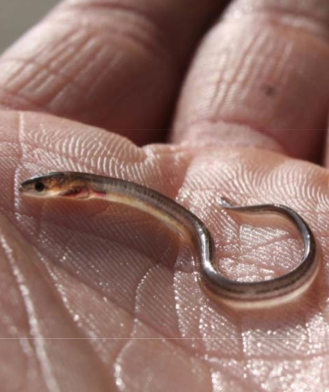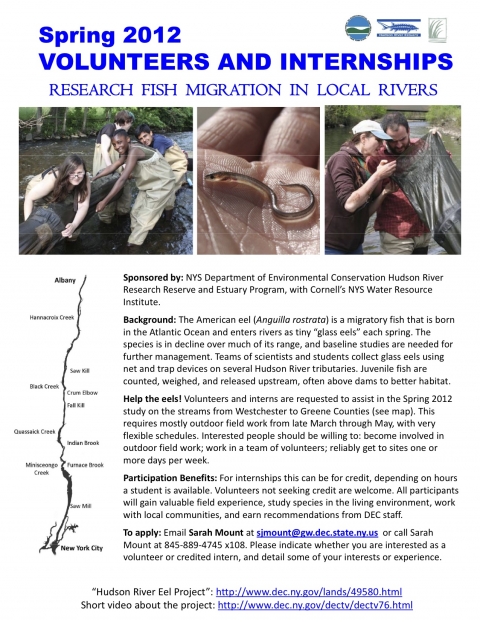
Above: A juvenile American eel, sometimes called a "glass eel." Photo via the NY DEC website.
The New York State Department of Environmental Conversation announced today that the number of migrating American eels in the Hudson River may break some records this year, according to an annual community-powered eel census.
Juvenile American eels, which are just two inches long, migrate 1000 miles from the Sargasso Sea to the Hudson River Hudson River every spring. They then live in upstate rivers and streams for decades before returning to the sea.
A press release from the DEC sent today states that the eels have "arrived a month earlier and in far greater numbers " than they have since the eel-census began:
For example, in 2011 at Black Creek in Ulster County, eels did not show significant numbers until early May and about 1,000 were caught throughout the eight-week season. However, on March 23 of this year, Scenic Hudson staff and volunteers counted more than 2,700 baby eels from a single night’s migration.
The DEC has been coordinating a vast eel-counting project staffed with high-schoolers and community members since 2008. This year, volunteers are enthusiastically invited to help out with with the count -- there are outposts of the project in both Ulster and Greene Counties. (See the flyer at the bottom of this post for more info, or contact Sarah Mount: sjmount@gw.dec.state.ny.us; (845) 889-4745 x.108 and/or Zoraida Maloney: ztmalone@gw.dec.state.ny.us; (845) 889-4745 x.107.)
Read the full press release from the DEC below:
CITIZEN SCIENTISTS SET TO TRACK RECORD NUMBER OF HUDSON RIVER EELS
Annual Juvenile Eel Migration is Larger and Earlier than Usual
High school students and community volunteers throughout the Hudson Valley are engaging in research on migrating juvenile American eels in Hudson River tributaries as part of New York State Department of Environmental Conservation’s (DEC) American Eel Research Project, the agency announced today.
American eels have one of the most unusual life cycles of any fish. They are born in the Sargasso Sea north of Puerto Rico, and every spring they arrive in estuaries like the Hudson River as translucent, two-inch long “glass eels.” As part of the research project, volunteers and students check a ten-foot cone-shaped net (“fyke net”) specifically designed to catch this small species and then they count and release the glass eels back into the water and record environmental data on temperature and tides. Most of the eels are released above dams and other barriers so that they have better access to habitat. Eels will live in freshwater streams and lakes for up to 20 years before returning to the sea.
“The American Eel Research project is an excellent way to connect students and the community with nature while gathering research that can be valuable for the future study of this species and its role in our ecosystem,” said Kathleen Moser, DEC’s Assistant Commissioner of Natural Resources. “We thank the hundreds of volunteers and partner organizations that continue to support the Eel Project and its annual research efforts.”
Now in its fifth year, volunteers and organizational support for the project has expanded greatly. The project is completed in partnership with the New York State Water Resources Institute at Cornell University and an Innovation Grant from TogetherGreen, a National Audubon program with support from Toyota. From mid-March through May, approximately 250 students, teachers, college interns and community volunteers check nets daily at different sites including:
-Hannacroix Creek in New Baltimore (Greene County)
-Saw Kill in Annandale-on-Hudson (Dutchess County)
-Black Creek in Esopus (Ulster County)
-Crum Elbow Creek in Hyde Park (Dutchess County)
-Fall Kill in Poughkeepsie (Dutchess County)
-Quassaick Creek in Newburgh (Orange County)
-Indian Brook in Cold Spring (Putnam County)
-Furnace Brook in Cortlandt (Westchester County)
-Minisceongo Creek in West Haverstraw (Rockland County)
In addition to the above sites, the project has expanded to New York City with help from key partners. The New York City Department of Environmental Protection (DEP) installed a fyke net in Staten Island, where thousands of glass eels have been caught and the Wildlife Conservation Society plans to install a net in the Bronx River with help from Queens College scientists. In addition, the New York Aquarium, the Hudson River Park Trust and Groundwork Yonkers have deployed “eel mops,” simple islands of artificial habitat that attract juvenile eels and serve as early indicators of eel migration.
“DEP is thrilled that the counts indicate high numbers of young American eels looking for a home in the Staten Island Bluebelt,” said Dana Gumb, Chief of the New York City Department of Environmental Protection’s Staten Island Bluebelt Unit. “For many years, the city has been investing hundreds of millions of dollars in building the award winning Bluebelt system to create a greener, greater New York. The fact that eels are thriving here shows that all our efforts have paid off.”
Just partway into the spring season, 2012 is likely going to be a record-breaking year for the project. Not only are there more sites and volunteers than ever before, but the eels arrived a month earlier and in far greater numbers than they have since the project started in 2008. For example, in 2011 at Black Creek in Ulster County, eels did not show significant numbers until early May and about 1,000 were caught throughout the eight-week season. However, on March 23 of this year, Scenic Hudson staff and volunteers counted more than 2,700 baby eels from a single night’s migration. Eels travel from sea to stream and back, therefore there are hundreds of factors that can affect them.
Volunteers include a wide range of students, environmental professionals and community residents. They are trained in basic protocols to assure quality data is collected and classroom visits by DEC educators help bring the project alive to hundreds of students. Data from this project will be submitted to multi-state management plans for conserving the eel, a valuable food and commercial resource in many states and countries. Several years ago, the Atlantic States Marine Fisheries Commission called for coastal states to monitor the migrations of American eels. This type of fish has existed for millions of years, yet eel numbers have declined in many East Coast rivers and the reasons are not known. Citizen-based research can help answer some basic questions about this very mysterious animal and restore them to the upstream habitats where they mature.
Eel collection happens at most sites daily through mid-May. As part of their work, volunteers also monitor river herring that migrate into tributaries to spawn. Photos, sampling schedules, and a list of partners for all sites are available. The project website is: http://www.dec.ny.gov/lands/49580.html. Project partners at Constitution Marsh Audubon have also set up a Facebook page: http://www.facebook.com/pages/Hudson-River-Eel-Project/166121100158224.















